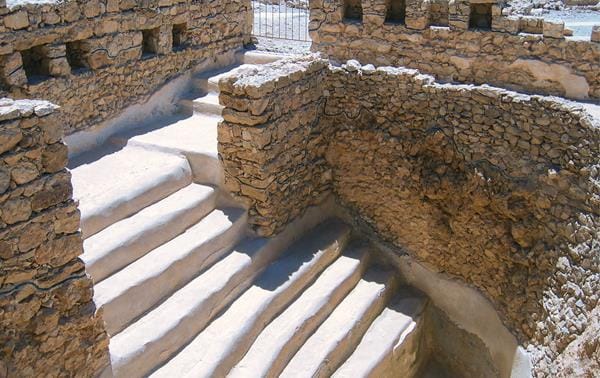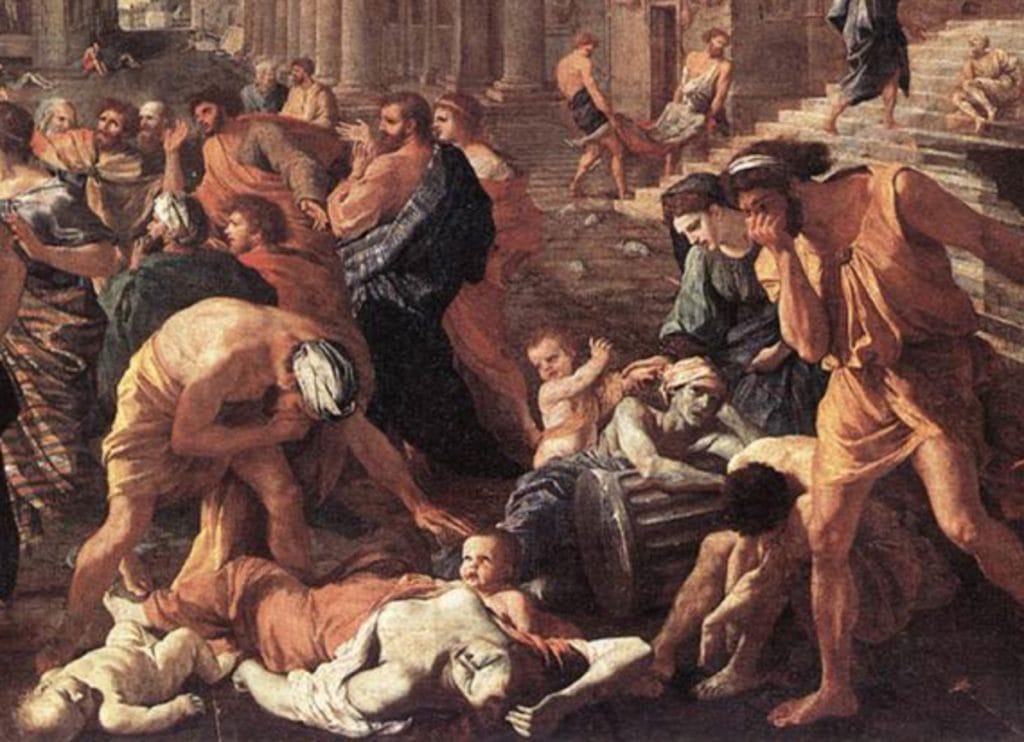
Christening vs Baptism Revealed
In the time of Jesus, being immersed in water was a ritual purification rite practiced by both Jews as well as pagans. The Jews used the practice in two ways. First and foremost, immersing a person in fresh running water occasionally accompanied by fasting, was seen as part the physical preparation of worship followed by the spiritual ritual of prayer. A second way was during the ritual in which a person converts from a pagan religion to that of Judaism. Further, during the very late first century B.C. and the early second century A.D., a purity fad swept Judah. It was seen as the height of purity and social stature for a house to have its own private mikveh. This consisted of steps leading below ground level down to a small shallow underground pool. This rock pool could have water provided by an adjacent spring, naturally existing ground water, or by rain water having been channeled into the pool. The water, according to mosaic law had to be fresh and free flowing. Public mikveh’s were located adjacent to most local synagogues and the Temple in Jerusalem. All parishioners we required to wash themselves before preceding into worship ceremonies.

The first time we hear of this water immersion ceremony in the Gospels is with the story of John the Baptist. He was primarily preaching to Jews who were looking for the imminent appearance of the long prophesied Messiah. Still others were simply looking for a way to please God and thus put themselves in a better relationship with Him as sinners. Most people considered John a holy man and a prophet. They were also attracted to his message that the Kingdom of God was now at hand. This message immediately attracted large crowds who wanted to be ceremonially immersed in water just in case the Messiah did in fact appear. John was also becoming revered as he was the first prophet to appear in Israel over the past four hundred years.
The act of water emersion transitioned from a Jewish purification rite to a Christian salvation rite with the Baptism of Jesus. Scripture tells us that the day before the start of His ministry, Jesus traveled east from the village of Nazareth and crossed the Jordan River into the Kingdom of Jordan. There He found John who was preaching and conducting a water purification ceremony for his Jewish attendees. John was confused when Jesus came to him to be baptized. However, Jesus told John that it was in the will of God that they perform this act even though He was without sin (Matthew 3:13-15). It was immediately after John baptized Jesus that he discovered why Jesus had allowed Himself to be Baptized.

First and foremost, when Jesus came up out of the water, John saw the Holy Spirit of God descend from Heaven and fully indwell Jesus. We later learn that this was a prophecy or sign given by God to John concerning the revealing of the Messiah (John 1:33). Second, as a Jew under the law, this ritual was in line with the accepted tradition of the purification for Temple priests. Last but not least, by Jesus participating in this rite, all who followed Him would also be baptized and also received the indwelling of the Holy Spirit.
The symbolism of baptism had now became more than just the Jewish ritual of cleaning one’s self before entering the Temple. First, it symbolized the intellectual change that occurs when a person comes to Christ. The person acknowledges they are living the life of a sinner, thus in active rebellion against God. By admitting this to themselves, their old sin self dies. Then, by being lowered into the water, they are symbolically dying to sin and burying their old flesh spirit in the grave. Then, coming up from the water, they are literally emerging from the grave and death. It is then that they are symbolically born again in the spirit. Their old flesh spirit is now enhanced by the indwelling of the Holy Spirit. They are also rewarded with an eternal spiritual life to be followed after death by immortal resurrected bodies. So, even if they die and are buried, their born again intelligent spirit will be alive and well with Christ. Additionally, their old sin body that was once disintegrating in a grave, will eventually be resurrected as a sin free body now translated to immortality. Further, when they go back into their everyday existence, the Holy Spirit will dramatically increased their consciousness and help guide them away from sin. They also no longer fear death as they now know where they are going in an afterlife. The fear of death is mankind’s greatest fear and so the greatest weapon of power in Satan’s arsenal. He is determined to ruin the joy of life by causing mankind to always dwell on their eventual death. Satan brought sin and its reward of physical and spiritual death into the world (John 8:44). Jesus brought salvation and eternal life to the world (John 3:16). So now death is simply a promotion to life eternal.
Therefore, Jesus allowed himself to be baptized to set an example. Scripture is also clear that Jesus did not baptize people (John 4:2). Instead, His disciples regularly performed this rite. Jesus did not baptize because He knew that those who He baptized would inevitably consider their baptism of higher value that those baptized by others. Also, he wanted to start the practice of His disciples and future ranking members of His church to baptize in order to create a tradition that would continue until His Second Coming.
So, Baptism in the Jewish and Christian religions was originally full immersion in water, and only made available to adults. Jewish law stated the Age of Accountability for children was nineteen years and younger (Numbers 32:11; Deuteronomy 1:39). This age limit insured that those baptized fully understood its significance and requested of their own free will that the rite be performed on them.

However, this practice dramatically changed when plagues began to appear around the Mediterranean area. In 165 A.D. the Roman Empire was struck by the first documented outbreak of a plague involving smallpox which quickly spread from the Middle East to the Mediterranean and throughout Europe. It started in Baghdad when Roman soldiers were sent to invade Parthia. By returning to Rome in 165 A.D. they spread the plague from Bagdad to Europe. Records show that at its apex, the disease was killing approximately 5,000 people per day. The scourge killed 90% of the population in areas of Egypt and more than 20% of the Roman Empire’s total population. But the most insidious outcome of smallpox was it high mortality rate among children.
In 166 A.D., Marcus Aurelius called for all religions to pray to their gods that the plague would cease. The Christian Church also prayed but was faced with a doctrinal issue concerning the baptism of children. The Church had never kept baptism from anyone who requested it. But, they were now being asked by parents to start baptizing their infants and children. The same practice of baptizing children would once again became a topic of heated debate in the 1950’s and 1960’s. The question was, could baptism be legitimately administered to a child who was intellectually unaware of what the sacred rite meant.
The first mention of child baptism comes from bishop Irenaeus c.180 A.D.(Adversus haereses 2.22.4). But it would be twenty years later when we find a clear statement concerning the baptism of children. Prolific writer and early church father Tertullian wrote in 200 A.D. that it was against church doctrine, in his opinion, for a child who was not aware of the significance of the rite to be baptized (De baptism 18.1.4-5). However, between the years 180 A.D. and 200 A.D., there is evidence that the baptism of children was quickly catching on within the Christian community. It seems to have become part of a legacy left by the earlier plague. The high infant mortality rate caused the parents of infected infants to literally beg priests to baptize their child to insure they would go to Heaven. And, even though Scripture has always held that all children automatically go to Heaven, still the parents wanted extra peace of mind, and priests finally acquiesce to their ardent pleas.
Once the epidemic was over, Irenaeus and other Christian theologians developed a theory of infant baptism to help legitimize the practice since child baptism was now so widespread that it was a commonly accepted tradition. Through the post apostle period, there is no reference to the baptism of children. Every time the subject came up it seems that children were flatly considered pure regardless of any small infraction committed on their part. This was orthodoxy up until the time of Christian theologian Justin c.150 A.D. who was the last apologist to write about baptism before the plague struck the Roman Empire (First Apology 61.9-10). But, after forty years and the ravages of the plague, the baptism of children was officially implemented unreservedly by the early Church.
Today, christening is carried out by Catholicism, Eastern Orthodoxy, Anglian, Lutheran, Presbyterian, Methodist, Nazarenes and United Protestants. However, most other denominations reserve baptism only for those mature enough to understand its significance in their spiritual journey. This is because there is no example in the New Testament of a child or adult being sprinkled with water and receiving the Holy Spirit. Instead, these dominations conduct what is called a dedication ceremony. At that time, Christian parents publicly announce the child's Christian name. They then make a solemn promise to the Lord, before a church congregation, to raise their child according to God's will. This practice is rooted in a passage found in Deuteronomy 6:4-7. Sometimes, godparents are named and also agree to insure the child is raised as a Christian. The ceremony typically includes a laying on of hands at which time a pastor prays over the child, and ends with the congregation singing a hymn. It is common for the parents to receive a gift and the child to receive a certificate commemorating the event. Usually, but not always, this simple infant dedication ceremony is later followed up by the person as an adult, consciously accepting Christ as their Saviour and being formally baptized. This brief ceremony usually involves full body emersion in water as was exemplified by Christ.
But again, Scripture is clear that, once a person declares privately or publicly that they receive Christ as their Lord and Saviour, they are immediately indwelled by the Holy Spirit. A person does not have to be baptized to be a Christian as this spiritual indwelling and intellectual transformation requires only Faith in Christ plus nothing else.
On a closing note, once a person is baptized, there is no need to be rebaptized. Yes, a person will sin after they are baptized, but their original baptism is still in effect as Jesus died for all sins for all time. A person may want to be rebaptized if they join another church, survive a trauma, are visiting the Holy Land, or simply a reaffirmation of faith. This is completely acceptable but not necessary. It is impossible for a person who has been baptized to become unbaptized. To do this, a person would have to declare that they no longer have faith in Christ, and begin to live a life of dedicated rebellion against God in all things. To accomplish this would mean that the person was never indwelled by the Holy Spirit in the first place. In other words, the person professed faith in Christ but did not mean it. The person only wanted to be baptized because they were pressured by family, or to impress others, or was mentally conflicted at that time. Thus, that the person was never indwelled by the Holy Spirit as God would have know in advance that the person was not sincere and would eventually rebel and leave the church. A person could experience a psychotic break due to a medical condition or trauma and reject God. But God knows a person's heart and so that person could still be saved. A person can even accept Christ on their death bed and be saved as was the robber on the cross next to Jesus (Luke 23:42-43).

That said, a person who has faith in the death, burial and resurrection of Christ and accepts Him as Savior, is guaranteed eternal life with or without baptism. Again, Faith plus nothing else! (Genesis 15:6)
If you enjoy the information provided on this site, please consider making a donation of any amount to help continue its production. Donate Now